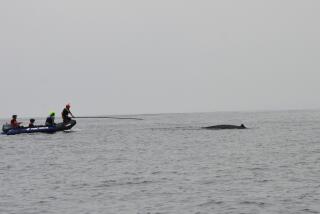Baby beluga -- first rescued in U.S. -- ânot out of the woodsâ
The two Alaskan fishermen had stopped to examine a bald eagle when they noticed something sleek and gray in the Bristol Bay surf: a baby beluga whale in the shallows, faintly whistling and clicking.
The whale, already dehydrated and disoriented, soon swam away, but then circled back to shore.
The fishermen began making phone calls. In almost no time, marine specialists raced in. The Alaska SeaLife Center â a research and rehabilitation organization â grounded local flights, then settled the whale calf on an air mattress, draped him in wet towels and airlifted him toward safety.
âIt was a nail-biting hour and a half,â SeaLife President and Chief Executive Tara Riemer Jones told The Times. âThey thought they lost him a couple times.â
PHOTOS: Rescued animals -- Boots, Feisty, Piper and more
But the baby beluga is a fighter, his handlers say. He survived the June 18 rescue and continues to recuperate, marking the first successful American rescue of a baby beluga whale on record.
Such a recovery is so rare that teams from around the country â including the Shedd Aquarium in Chicago, the Georgia Aquarium in Atlanta and SeaWorld in San Diego â have flown in to help with the calfâs around-the-clock feedings and care. The efforts cost more than $2,000 a day, Jones estimates.
The newborn was most likely separated from his mother during a fierce windstorm off the southwestern coast of Alaska, Jones said, and never drank her milk. A baby mammalâs first feedings provide antibodies that build a strong immune system. The beluga now has little to no protection against disease.
Recovery from the trauma of starting life alone in a big ocean may take months, Jones said. Typically, baby whales stay with their mothers for two years.
âJust like a baby in the NICU, it can go either way,â Jones said. âHeâs on the path, but not out of the woods.â
The calf was underweight, dehydrated and hypoglycemic when he was checked into the pool. Feedings through a stomach tube and a bottle, when he takes it, have brought the 5-foot calfâs weight up to 115 pounds. He has begun to tentatively whistle and click again through his blowhole, the cetacean version of a newbornâs first wails.
Until his weight improves and his immune system stabilizes, two marine mammal workers remain with the calf at all times. To keep him alert and entertained, they use the whale version of pool toys: foam noodles, plastic kelp and weighted balls.
When heâs tired, he swims slowly, one side of his brain asleep. When heâs alert, he darts in circles around his handlers, nuzzling them with his rubbery skin, his broad nose stretched in what looks like a smile.
The whale will live in captivity. The National Fishery Service calls him non-releasable: Because he isnât growing up in the wild, he simply wouldnât have the skills to survive. Six aquariums in the country have beluga populations, and officials will analyze which environment will be most appropriate: one with a younger whale to buddy around with, perhaps, or one with a maternal figure who can take the calf under her fin.
Naming him will wait, handlers say, until he finds a home â and until theyâre certain he will survive.
In caring for the baby beluga during his two-week stretch of 12-hour days in Alaska, SeaWorld mammal curator Bill Winhall drew on special formulas and techniques from another baby whale he helped rear. Two years ago, SeaWorld hand-raised Pearl, a baby beluga rejected by her mother, Ruby.
âWe get attached to these little guys,â Winhall said. âWhen he swims by and rubs you, or when I rub him down, it reminds me of rubbing down my dog. You know that feeling. âGood dog. Good dog.â You canât help but love them.â
ALSO:
Shell may be ready for the Arctic, but its oil spill barge isnât
Episcopal Church expected to OK liturgy for same-sex couples
Lou Gehrig baseball is nice, student debt isnât: Start the auction
Follow Laura on Twitter. Email: [email protected].
More to Read
Sign up for Essential California
The most important California stories and recommendations in your inbox every morning.
You may occasionally receive promotional content from the Los Angeles Times.











